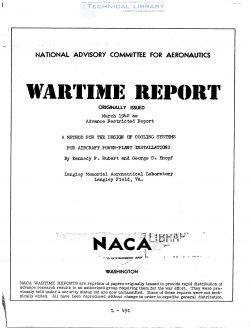naca-wr-l-491
- Version
- 164 Downloads
- 916.14 KB File Size
- 1 File Count
- April 2, 2017 Create Date
- April 2, 2017 Last Updated
A Method for the Design of Cooling Systems for Aircraft Power Plant Installations

INTRODUCTION
A method of organizing design calculations for the cooling systems
of aircraft power-plant installations has been developed for use by
representatives of airplane and engine companies invited by the Materiel
Division, Army Air Corps Liaison Office to participate in the activi-
ties of the NADA power-plant installation section at the Langley
Memorial Aeronautical Laboratory, Langley Field,, Va.
A schematic arrangement of a heat exchanger with a cooling-air
duct is shown in figure 1. The system consists of three parts:
(1) the entrance duct, which slows down the cooling air and converts
most of its dynamic pressure to static pressurei (2) the heat exchanger,
in which some of the static pressure is lost; and (3) the exit duct,
which converts tb dynamic pressure any surplus of static pressure
above the value at the exit.
At station 0 in the free stream ahead of the entrance, the air
has a static pressure Po, a Velocity V0 relative to the duct, and
a dynamic pressure go. As the air approaches the entrance at
station 1, its velocity decreases, and the dynamic pressure is partly
converted to static pressure. From station 1 to station 2 the
velocity continues to decrease, usually to the point where the dynamic
pressure is negligible, with a corresponding further increase in static
pressure. As a result of the losses in the entrance section, the
increase in static pressure from station 0 to station 2 is less than
the decrease in the dynamic pressure.
The air on entering the heat exchanger is accelerated because of
the reduction in free area and on leaving is decelerated to a velocity
equal to the velocity at station 2. The internal resistance of the
heat exchanger causes a relatively large loss of static pressure.
From station 3 to the outlet the static pressure drops to that of
the free stream, and the dynamic pressure rises to a value less than
that of the free-stream dynamic pressure by an amount equal to the sum
of the losses of the entire system.
The addition of heat to the cooling air in the heat exchanger
makes no change in these fundamental principles; but, in the calculation
of the internal horsepower and the exit area, the effect of the heat
on the density of the air must be taken into account.
SYMBOLS
duct cross-sectional area, sgusre feet
compressibility factor
weight rate of air flow, pounds per second
static pressure, pounds per square foot
pressure loss, pounds per square foot
volume rate of air flow) cubic feet per second
temperature, °F absolute
temperature rise, °F
velocity, feet per second
acceleration of gravity, feet per second per second
dynamic pressure, pounds per séurre foot
mass density, slugs per cubic foot
relative density 5—582373
width
la
: :3'O.ntn-d§: ‘DI§'“"&F"
Subscripts:
0, l, 2, 3, h stttien numbers as in figure 1
ILLUSTREIVE EXIJL'PLES
Computations selected from an cnalysis nndo in conjunction with
one of the designs developed by members of the Hitch power-plant in-
stallation section are used to demonstrr.te the system of calcula—
tions. Design values that occur throughout the example have been
selected for the particular design under consideration; where
possible, references are listed for selecting similar values for
other types of design.
The power-plant installation was designed for a long-range
bomber, powered by four 2000-horsepowor engines equipped with turbo-
superchargers. The pertinent data for the engines are given in table
I and for the airplane performance ere given in table II.
A general arrangement of the power-plant installation is shown
in figure 2. All cooling rnd chrrge rir is taken in at the nose of
the oowling: Air for the supercharger intrkn, oil coolers, and
intercoolers enters through the outer annulus and flows through duets
distributed around the periphery of the engine. Cooling air for the
engine flows through the inner annulus over the engine and is dis-
charged through outlets between the chrrgo-air and the cooling-air
ducts.
L-491
All cooling calculations are based on Army summer air, which has
the same pre_ssure as standard air (reference 1) but has a temperature
h0° F greater than standard throughout the range considered. Pro-
perties of this air are given in table III.
| File | Action |
|---|---|
| naca-wr-l-491 A Method for the Design of Cooling Systems for Aircraft Power Plant Installations.pdf | Download |

Comment On This Post